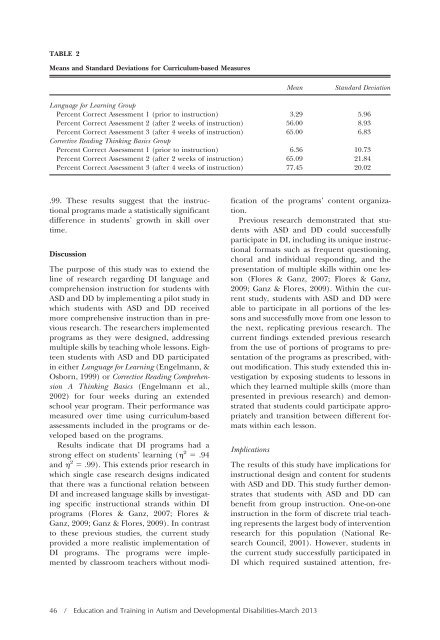etadd_48(1) - Division on Autism and Developmental Disabilities
etadd_48(1) - Division on Autism and Developmental Disabilities
etadd_48(1) - Division on Autism and Developmental Disabilities
You also want an ePaper? Increase the reach of your titles
YUMPU automatically turns print PDFs into web optimized ePapers that Google loves.
TABLE 2<br />
Means <strong>and</strong> St<strong>and</strong>ard Deviati<strong>on</strong>s for Curriculum-based Measures<br />
.99. These results suggest that the instructi<strong>on</strong>al<br />
programs made a statistically significant<br />
difference in students’ growth in skill over<br />
time.<br />
Discussi<strong>on</strong><br />
The purpose of this study was to extend the<br />
line of research regarding DI language <strong>and</strong><br />
comprehensi<strong>on</strong> instructi<strong>on</strong> for students with<br />
ASD <strong>and</strong> DD by implementing a pilot study in<br />
which students with ASD <strong>and</strong> DD received<br />
more comprehensive instructi<strong>on</strong> than in previous<br />
research. The researchers implemented<br />
programs as they were designed, addressing<br />
multiple skills by teaching whole less<strong>on</strong>s. Eighteen<br />
students with ASD <strong>and</strong> DD participated<br />
in either Language for Learning (Engelmann, &<br />
Osborn, 1999) or Corrective Reading Comprehensi<strong>on</strong><br />
A Thinking Basics (Engelmann et al.,<br />
2002) for four weeks during an extended<br />
school year program. Their performance was<br />
measured over time using curriculum-based<br />
assessments included in the programs or developed<br />
based <strong>on</strong> the programs.<br />
Results indicate that DI programs had a<br />
str<strong>on</strong>g effect <strong>on</strong> students’ learning ( 2 .94<br />
<strong>and</strong> 2 .99). This extends prior research in<br />
which single case research designs indicated<br />
that there was a functi<strong>on</strong>al relati<strong>on</strong> between<br />
DI <strong>and</strong> increased language skills by investigating<br />
specific instructi<strong>on</strong>al str<strong>and</strong>s within DI<br />
programs (Flores & Ganz, 2007; Flores &<br />
Ganz, 2009; Ganz & Flores, 2009). In c<strong>on</strong>trast<br />
to these previous studies, the current study<br />
provided a more realistic implementati<strong>on</strong> of<br />
DI programs. The programs were implemented<br />
by classroom teachers without modi-<br />
ficati<strong>on</strong> of the programs’ c<strong>on</strong>tent organizati<strong>on</strong>.<br />
Previous research dem<strong>on</strong>strated that students<br />
with ASD <strong>and</strong> DD could successfully<br />
participate in DI, including its unique instructi<strong>on</strong>al<br />
formats such as frequent questi<strong>on</strong>ing,<br />
choral <strong>and</strong> individual resp<strong>on</strong>ding, <strong>and</strong> the<br />
presentati<strong>on</strong> of multiple skills within <strong>on</strong>e less<strong>on</strong><br />
(Flores & Ganz, 2007; Flores & Ganz,<br />
2009; Ganz & Flores, 2009). Within the current<br />
study, students with ASD <strong>and</strong> DD were<br />
able to participate in all porti<strong>on</strong>s of the less<strong>on</strong>s<br />
<strong>and</strong> successfully move from <strong>on</strong>e less<strong>on</strong> to<br />
the next, replicating previous research. The<br />
current findings extended previous research<br />
from the use of porti<strong>on</strong>s of programs to presentati<strong>on</strong><br />
of the programs as prescribed, without<br />
modificati<strong>on</strong>. This study extended this investigati<strong>on</strong><br />
by exposing students to less<strong>on</strong>s in<br />
which they learned multiple skills (more than<br />
presented in previous research) <strong>and</strong> dem<strong>on</strong>strated<br />
that students could participate appropriately<br />
<strong>and</strong> transiti<strong>on</strong> between different formats<br />
within each less<strong>on</strong>.<br />
Implicati<strong>on</strong>s<br />
Mean St<strong>and</strong>ard Deviati<strong>on</strong><br />
Language for Learning Group<br />
Percent Correct Assessment 1 (prior to instructi<strong>on</strong>) 3.29 5.96<br />
Percent Correct Assessment 2 (after 2 weeks of instructi<strong>on</strong>) 56.00 8.93<br />
Percent Correct Assessment 3 (after 4 weeks of instructi<strong>on</strong>) 65.00 6.83<br />
Corrective Reading Thinking Basics Group<br />
Percent Correct Assessment 1 (prior to instructi<strong>on</strong>) 6.36 10.73<br />
Percent Correct Assessment 2 (after 2 weeks of instructi<strong>on</strong>) 65.09 21.84<br />
Percent Correct Assessment 3 (after 4 weeks of instructi<strong>on</strong>) 77.45 20.02<br />
The results of this study have implicati<strong>on</strong>s for<br />
instructi<strong>on</strong>al design <strong>and</strong> c<strong>on</strong>tent for students<br />
with ASD <strong>and</strong> DD. This study further dem<strong>on</strong>strates<br />
that students with ASD <strong>and</strong> DD can<br />
benefit from group instructi<strong>on</strong>. One-<strong>on</strong>-<strong>on</strong>e<br />
instructi<strong>on</strong> in the form of discrete trial teaching<br />
represents the largest body of interventi<strong>on</strong><br />
research for this populati<strong>on</strong> (Nati<strong>on</strong>al Research<br />
Council, 2001). However, students in<br />
the current study successfully participated in<br />
DI which required sustained attenti<strong>on</strong>, fre-<br />
46 / Educati<strong>on</strong> <strong>and</strong> Training in <strong>Autism</strong> <strong>and</strong> <strong>Developmental</strong> <strong>Disabilities</strong>-March 2013
















